
It’s been a 12 months since I revealed my Google Adverts Pacing Dashboard to Search Engine Journal, and digital advertising and marketing adjustments fairly rapidly in a 12 months.
Google Information Studio modified the way it handles blended information, then modified its identify altogether (Hey, Looker Studio!).
What hasn’t modified is that we nonetheless can’t add targets and targets to the Google Adverts platform, so we nonetheless want separate dashboards to trace pacing and progress.
Screenshot of Looker Studio, November 2022
On this tutorial, we’ll cowl easy methods to entry and use the pacing dashboard, what’s new, and easy methods to get probably the most out of it.
Then, we’ll take a broader have a look at what an incredible pacing dashboard should have that will help you in your profession.
Step 1: Entry And Prep Your Templates
A completely automated pacing dashboard requires actuals, targets, and a strategy to mix the 2:
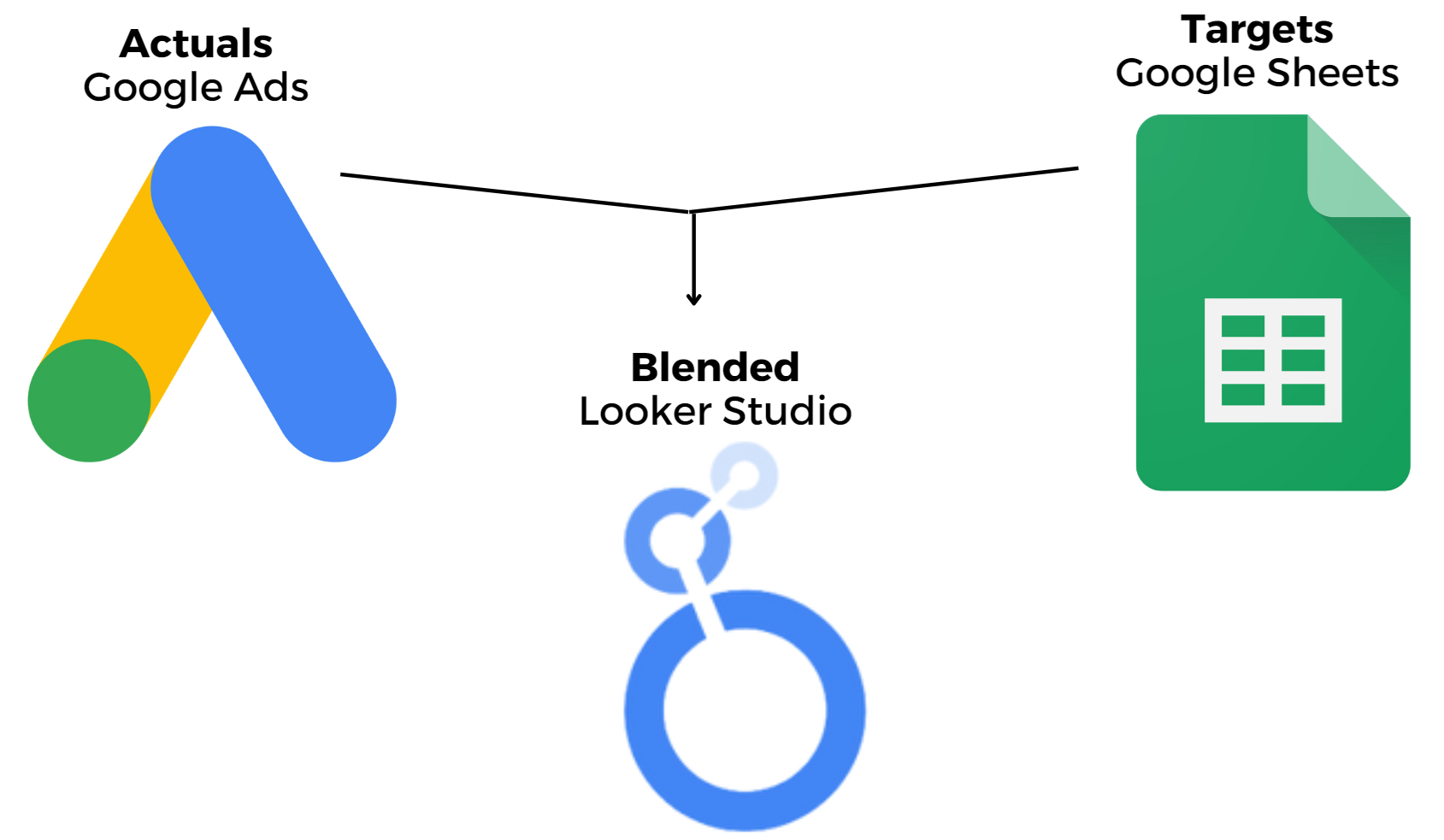 Picture created by writer, November 2022
Picture created by writer, November 2022
- Actuals: Google Adverts Account Efficiency Information: A direct connection to a Google Adverts account provides you real-time spend and conversion information and historic traits.
- Targets: Inner Targets and Targets Set Manually in Google Sheets: By recording KPI targets in a Google Sheet, you may populate month-to-date and day by day pacing targets.
- Mixed: Looker Studio Blended Information: Looker Studio will use blended information to calculate metrics from each Adverts and Sheets.
Now that you simply perceive how this can work, it’s time to get your templates.
1. Seize The Templates
First, use this hyperlink to obtain your free templates.
There are two dashboard variations to select from:
- Conversions (for lead era).
- Income (for ecommerce).
As defined above, you want each the Looker Studio and Google Sheets recordsdata for this pacing dashboard to work appropriately.
2. Replace Your Copy Of Google Sheets Pacing Template
That is the place you’ll enter vital info like your account identify and targets.
- Click on “Make a replica” of the Google Sheets Pacing Template.
- Change the identify of the Google Sheet to mirror your account(s).
- In Column A, enter the identify of your Google Adverts account. (The account identify features because the blended information “be part of key,” so it should match precisely!)
- Enter your spend and KPI targets in Columns D and E.
 Screenshot of writer’s Google Sheet template, November 2022
Screenshot of writer’s Google Sheet template, November 2022
That’s it for this sheet! The whole lot else is calculated mechanically.
3. Replace Your Copy Of The Looker Studio Dashboard
- Open the Looker Studio Pacing Report and click on the three dots on the highest proper to “Make a replica.”
- You’ll be prompted to decide on New Information Sources. Choose your Google Adverts account and the Google Sheets pacing template you simply created. It’s possible you’ll have to “Add New Information Supply” to entry them.
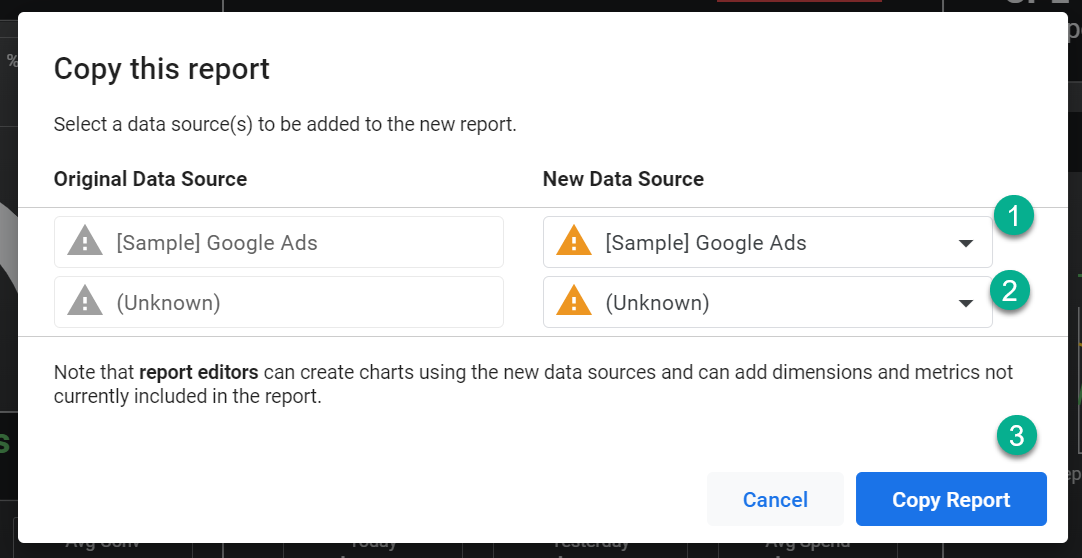 Screenshot from Looker Studio, November 2022
Screenshot from Looker Studio, November 2022
Step 2: Overview The Dashboard Format
We’ll undergo the Income Dashboard part by part right here.
Replace your information and templates earlier than strolling by means of the dashboard, so you may test for inconsistencies and determine customizations you’ll make within the subsequent step.
Your Google Adverts information and month-to-month targets must be correct, however you’ll have to make some changes to the day by day pacing charts and widgets in a while.
KPI Relationships Part
The dashboard leads with KPIs for spend and income (or conversions, relying on which model you’re utilizing). You’ll know precisely what the objective for the month is, what real-time efficiency is, and the way you’re pacing.
Monitoring MTD objective progress in opposition to how a lot of the month has handed lets you recognize whether or not it’s time to look at or time to behave.
Key efficiency indicators in a number of codecs (uncooked numbers, ratios, percentages) present pacing and information relationships with out requiring you to divide massive numbers by 30.4 in your head to reach at day by day averages.
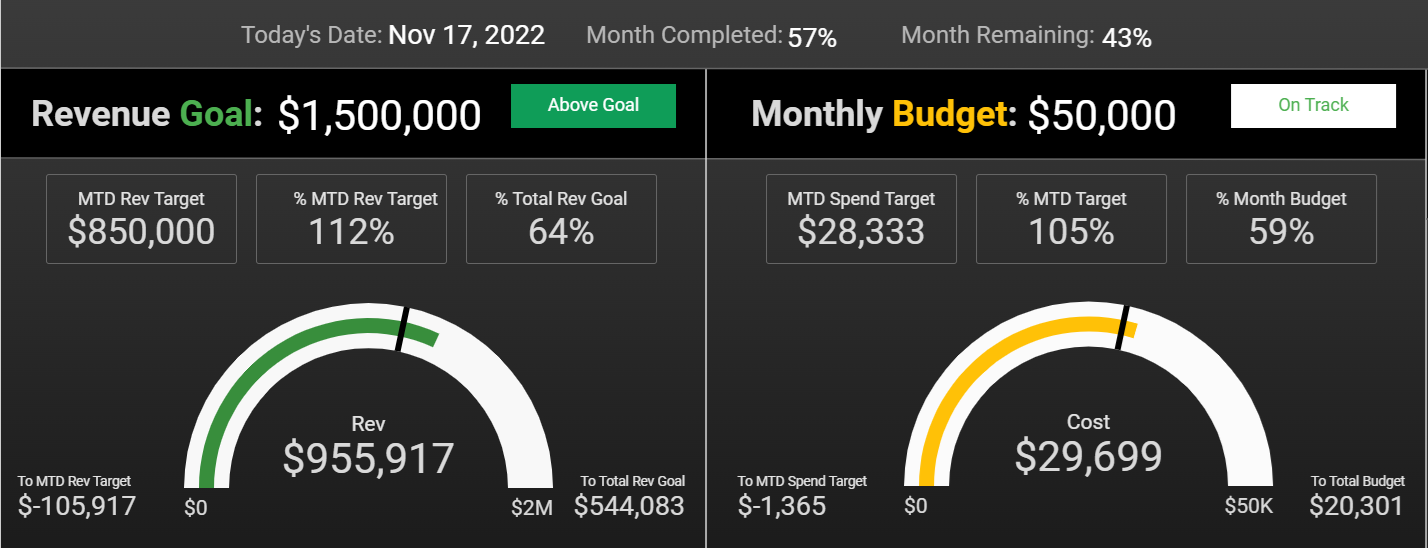 Screenshot from Looker Studio, November 2022
Screenshot from Looker Studio, November 2022
Charts And Scorecards Used:
- Month Progress: At the moment’s date, % of month accomplished, and remaining.
- KPI Aim Scorecards: Income (or conversion) objective and month-to-month price range.
- KPI Pacing Widget: A single-cell desk that returns an announcement primarily based on pacing.
- MTD Goal Scorecards: MTD goal value, % completion of MTD goal, and complete month-to-month objective.
- Gauge With Vary: KPI efficiency up to now with progress visualization.
- MTD Scorecards: value distinction between precise efficiency and targets.
Return Ratio
This part compares spend to return. The goal is mechanically populated primarily based on targets and doesn’t should be set individually.
You’ll see a unique part relying on whether or not you’re utilizing the Income or Conversion Dashboard.
The Income Dashboard for ecommerce shows ROAS (return on advert spend). The Conversion Dashboard for lead era and basic conversion monitoring shows CPL (value per lead).
 Screenshot from Looker Studio, November 2022
Screenshot from Looker Studio, November 2022
Day by day Progress And Course Correction
Right here, you may see the way you’ve been doing (common day by day efficiency) and the way you might be doing (latest day by day efficiency).
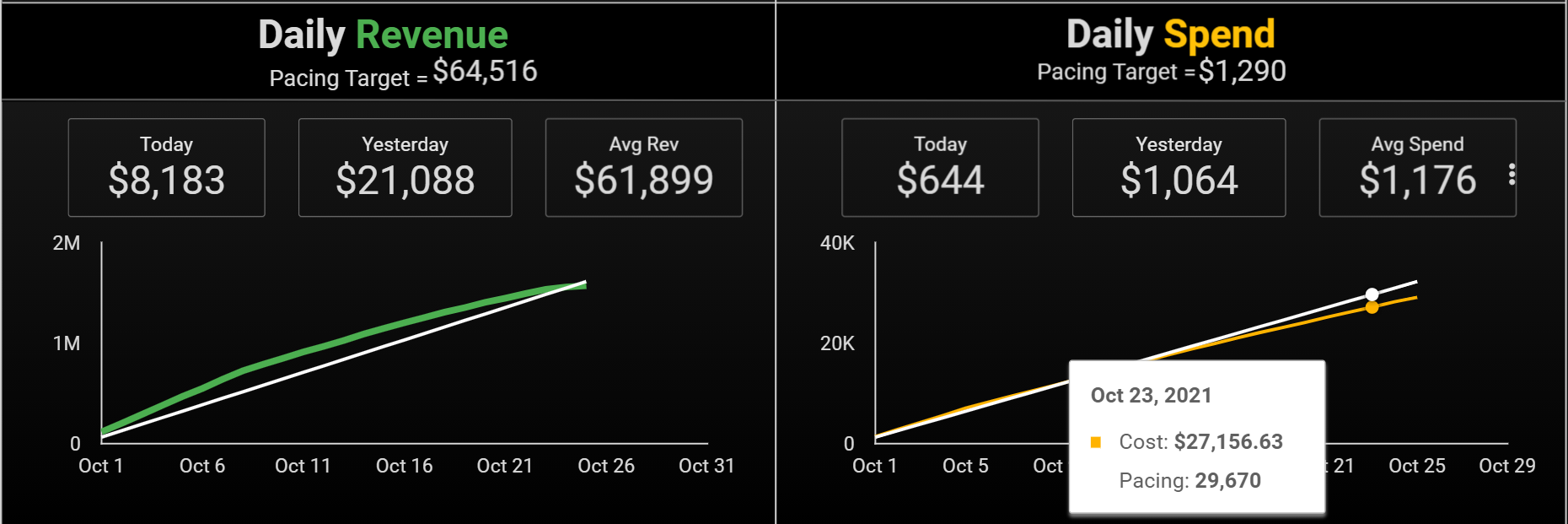 Screenshot from Looker Studio, November 2022
Screenshot from Looker Studio, November 2022
Within the account used on this screenshot, my day by day income will all the time path under the goal. That’s due to conversion lag time, and I’m going to notice it however not fear about the truth that yesterday’s income is just a 3rd of the day by day objective. In two weeks, it’ll inform a unique story.
Charts And Scorecards Used:
- Day by day Pacing Goal: Goal divided by days within the month.
- Efficiency Scorecards: At the moment, yesterday, and common.
- Time Collection Chart: Cumulative efficiency in comparison with pacing goal.
I’ve discovered that additional particulars, comparable to MTD tables with day by day variance, distract my focus from the larger image (are we pacing to hit our targets?), so I didn’t embrace it within the dashboard.
Should you’re the form of one that desires to see the specifics of previous day by day efficiency each time you test in on pacing, you may definitely add it to your report.
Historic Efficiency Part
Most of us don’t have a photographic reminiscence of how seasonality impacts every account, so there’s a reference part for that within the dashboard.
 Screenshot from Looker Studio, November 2022
Screenshot from Looker Studio, November 2022
These historic charts offer you pattern information and context for real-time efficiency.
Charts Used:
- Time Collection Chart: Final 30 days for KPIs.
- Time Collection Chart: Final 13 months for KPIs.
In case your base information seems to be correct, it’s time to maneuver on to customizations. (Should you see errors, bounce all the way down to Step 5 for troubleshooting assist.)
Step 3: Customise And Replace Your Dashboard
These edits and customizations gives you full management over the dashboard to mirror your personal wants and preferences. Don’t skip this part, or your targets gained’t match your precise targets.
1. Replace Chart Pacing Targets
To get chart ranges to match your targets, you’ll have to do some mild customization. As a result of it includes onerous coding, you’ll need to maintain them up-to-date whenever you get new targets.
Hardcode The Gauge Chart Max Axis
The “Axis Max” on the gauge charts gained’t mirror your goal with out handbook enter.
Enter the axis of your gauge charts by doing the next:
- Choose the gauge chart within the dashboard.
- Choose the Model panel.
- Change the Axis Max to match the month’s objective proven above the chart.
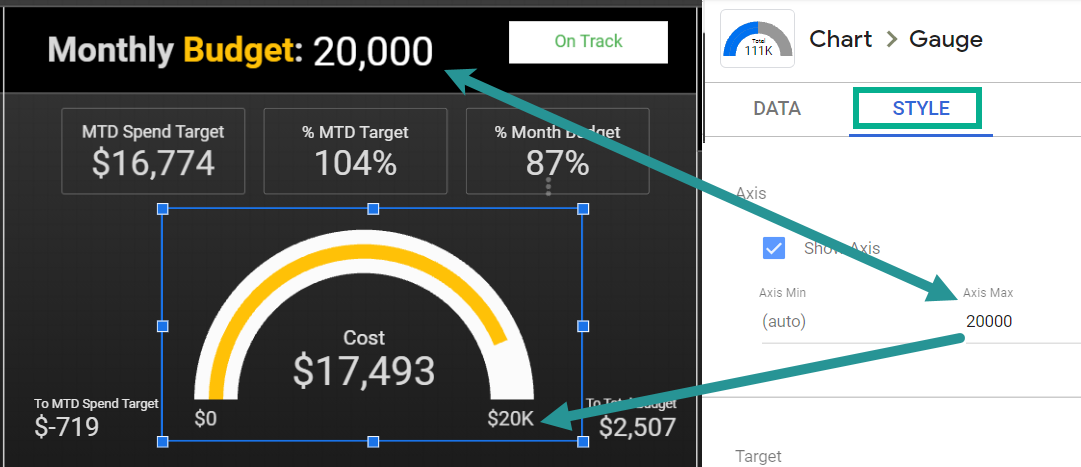 Screenshot from Looker Studio, November 2022
Screenshot from Looker Studio, November 2022
Hardcode The Time Collection Pacing Metric
Create a continuing day by day pacing goal with these steps:
- Choose the day by day pacing time sequence chart within the dashboard.
- From the Setup panel, choose the calculated Pacing metric.
- Replace the primary quantity within the method to match the pacing goal above the chart. (Word: “[Metric] * 0” doesn’t should be up to date, it merely calculates as “0”, which is required for the method to validate.)
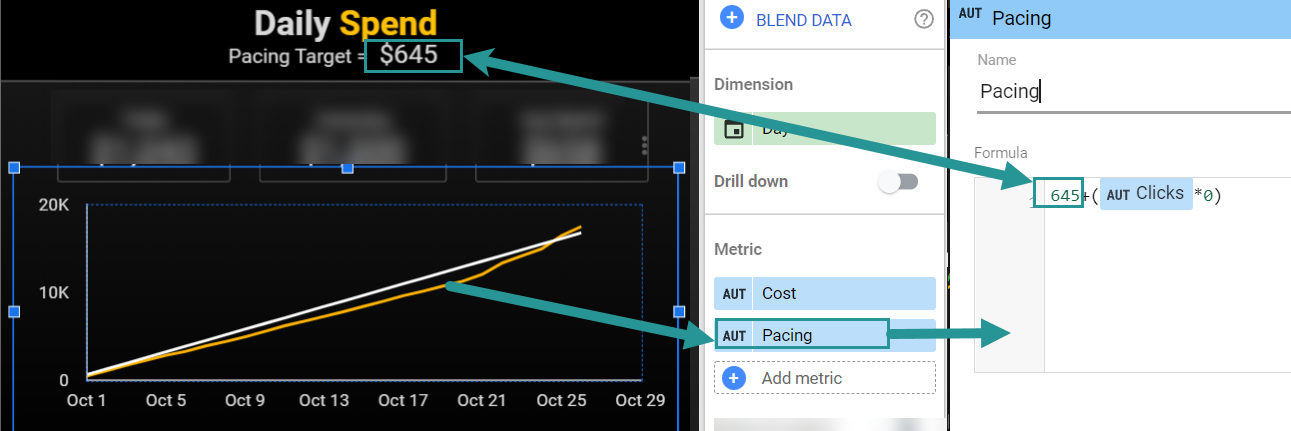 Screenshot from Looker Studio, November 2022
Screenshot from Looker Studio, November 2022
The Day by day Pacing Goal above the chart will mechanically replace as the times in a month change. You’ll simply have to edit the hardcoded Pacing Metric within the time sequence chart to match that new value.
2. Modify The KPI Pacing Widget (Optionally available)
Subsequent to every KPI is a color-coded button indicating the pacing standing. You possibly can customise the colours, textual content, and intervals.
 Screenshot from Looker Studio, November 2022
Screenshot from Looker Studio, November 2022
Edit the dimension’s calculated subject to alter phrasing or interval. The price range pacing subject will seem like this by default:
CASE
WHEN (Price/MTD Spend Goal) < .9 THEN "Underpacing"
WHEN (Price/MTD Spend Goal) >= .91 and (Price/MTD Spend Goal) < 1.1 THEN "On Observe"
WHEN (Price/MTD Spend Goal) > 1.1 THEN “Overpacing”
END
You possibly can change the values if, as an example, you need “on observe” to be inside 5% of the objective fairly than 10%. You may also create extra variants or edit the return statements.
To vary the background and textual content coloration, merely edit the conditional formatting within the Model panel.
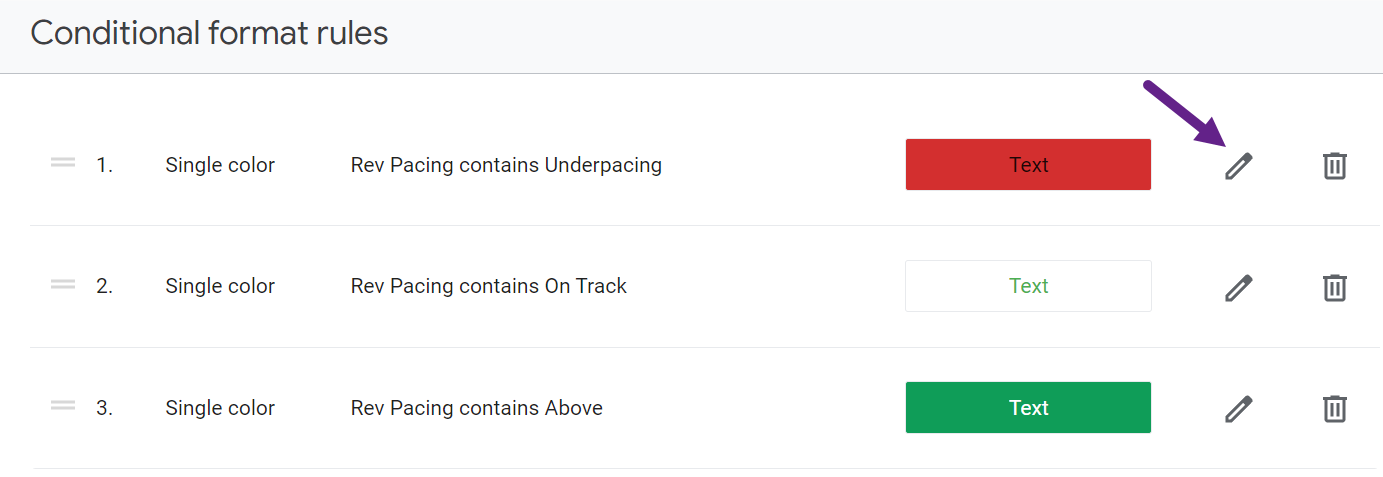 Screenshot from Looker Studio, November 2022
Screenshot from Looker Studio, November 2022
Different Customizations
As a result of the template is 100% customizable, you may make any updates you need, from altering the forex to setting completely different weekend/weekday and even day by day pacing targets. You may also arrange a single Google Sheet as a knowledge supply for all of your reviews.
Step 4: Use Your Dashboard To Make Choices
I don’t just like the phrase “let the info resolve” as a result of information doesn’t make choices. We do.
The fantastic thing about this pacing dashboard is that it provides you immediate entry to the info you should make strategic, knowledgeable choices.
A script can mechanically pause campaigns when spend is high, however it may’t seek the advice of along with your consumer about how to answer market adjustments.
Since most of us handle accounts that have to hit conversion targets and never merely “spend X price range each month,” figuring out precisely how spend and returns are pacing in opposition to targets can elevate your administration expertise.
Right here’s how one can take motion on dashboard insights in a means that positions you as a strategic companion in your shoppers.
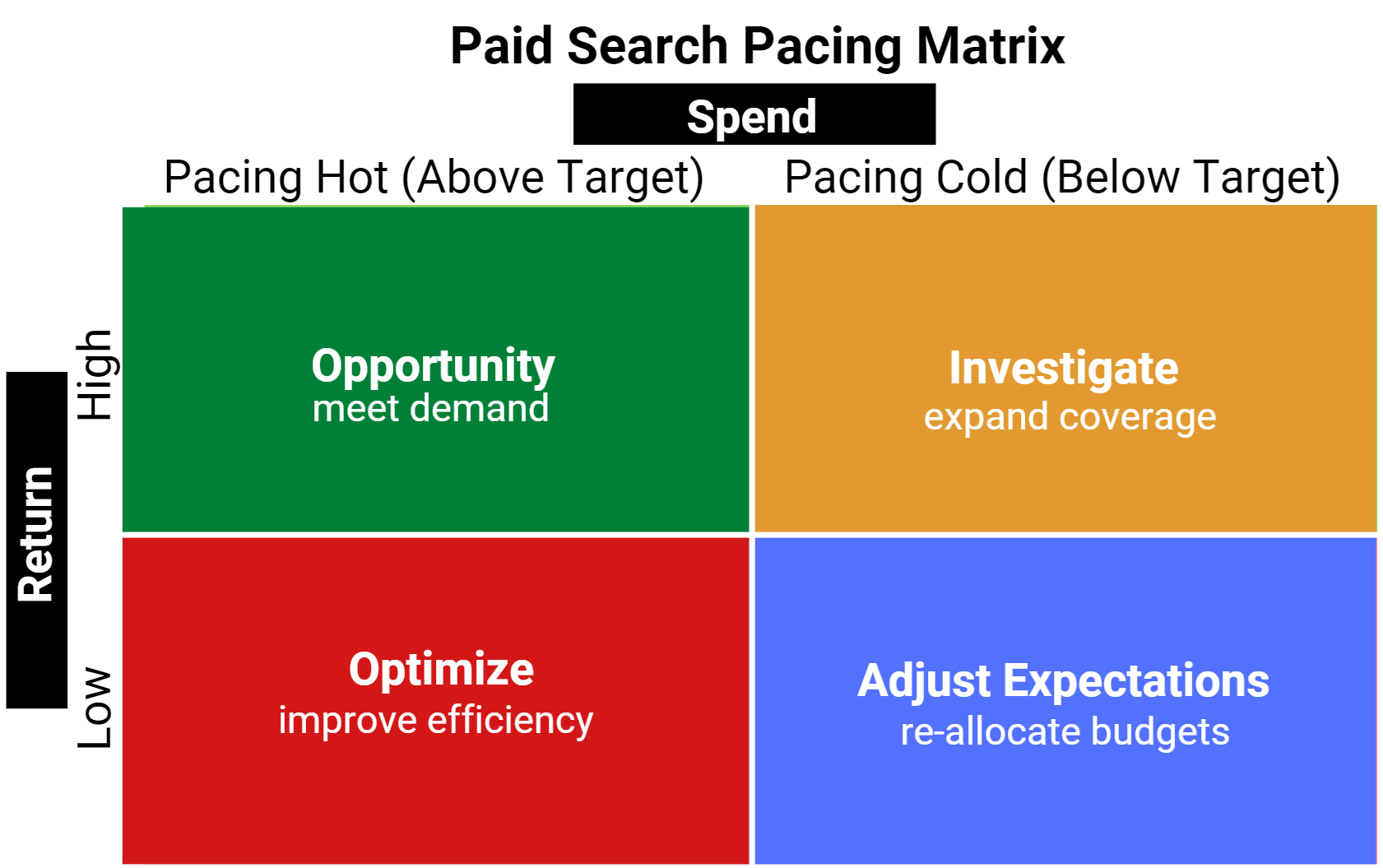 Picture created by writer, November 2022
Picture created by writer, November 2022
Sizzling/Excessive: Alternative.
When efficiency is stronger than anticipated, speak to your consumer about growing the price range to fulfill the demand, so that you don’t go away gross sales and leads on the desk.
Sizzling Spend/Low Returns: Optimize.
While you’re overspending and don’t have a lot to point out for it, it’s time to optimize for effectivity. Decrease bids and budgets, and pause or take away poor performers.
Chilly Spend/Excessive Returns: Examine.
When the spend is low, however the return is above the objective, the temptation is to have fun. Earlier than you do, take a deeper look into easy methods to use the accessible price range for top-of-funnel efforts or higher returns.
Chilly/Low: Alter Expectations.
If the demand simply isn’t there, it could be greatest to regulate the price range, shifting allotted funds to a interval that wants it.
Step 5: Troubleshooting And Upkeep
If one thing isn’t working in your dashboard, begin by checking these areas:
“Null” Or “No Information” Errors
- Is the blended information “be part of key” in Looker Studio precisely the identical in each your Sheets and Google Adverts information sources? Examine the identify of the account within the high left nook of the dashboard and ensure there are not any typos within the cell AI of your Google Sheet.
- Are you utilizing the proper information supply? Word that this template works immediately with the Google Adverts platform, not Google Analytics information about Google Adverts campaigns.
Pacing Or Accuracy Errors
- Is the date vary set to customized (month up to now, and many others.)? It must be on customized, not auto.
- Have you ever appropriately hardcoded the axis and pacing fields along with your targets? Overview Step 3 above.
Do not forget that as a result of the pacing template requires some onerous coding for visualizations, you’ll have to edit your targets within the dashboard to remain present when your targets change.
The Use Case For The Google Adverts Pacing Dashboard
As paid search managers, typically we don’t have all of the instruments we have to do our job. Even easy duties like Google Adverts pacing may be a lot more durable than they need to be.
That’s as a result of you may’t enter your price range or conversion targets immediately into the platform.
With out that primary context of targets vs. actuals, it turns into onerous to know the appropriate motion to take.
Most third-party software program and DIY pacing sheets making an attempt to unravel this downside simply aren’t helpful to paid search managers.
They’re both too primary to offer insights or too busy to be understood at a look.
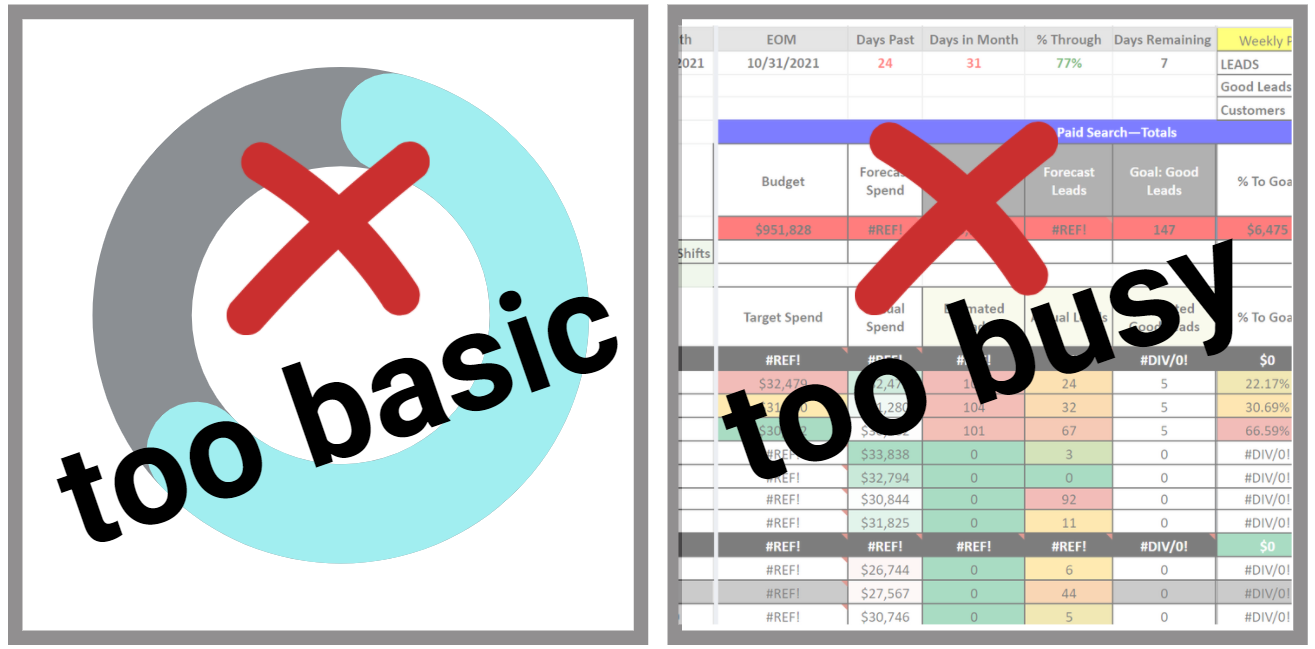 Picture created by writer, November 2022
Picture created by writer, November 2022
As a result of I couldn’t discover the proper automated dashboard, I made a decision to construct my very own.
Pacing Dashboard Necessities
A pacing dashboard wants to provide you quick access to information that drives strategic choices and motion.
Right here’s my very own top-five want listing for what I need in a pacing dashboard. As you may see, this listing immediately knowledgeable the template I in the end constructed:
- KPI snapshots and relationships. I would like to know the connection between what ought to occur (targets and month-to-date targets) and what’s occurring (actuals).
- Present day by day progress. I need to see the day by day pacing targets wanted to succeed in month-to-month KPIs and whether or not the account is persistently hitting these targets. What course correction, if any, has occurred? What adjustments nonetheless should be made?
- Present context. I need to see how this month’s efficiency compares to latest and longer-term traits.
- Automated. Except my price range or income targets change mid-month, I shouldn’t have to the touch or replace something.
- Accessible and shareable. Let me entry and share with my workforce or shoppers with out logins, downloads, or attachments. (Experiences are simply sharable from Looker Studio.)
Conclusion
Having immediate entry to efficiency targets and actuals provides you insights that may make you a extra strategic paid search marketer.
This Google Adverts pacing dashboard isn’t totally plug-and-play, however hopefully, you’ll discover that the value you get from it far outweighs the “funding” of holding it up to date.
Use the dashboard to fulfill the calls for of your personal pacing wants and drive higher administration choices in your shoppers.
Extra Sources:
Featured Picture: fizkes/Shutterstock
canadian pharmacy [url=https://canadianonlinepharmacieslegitimate.flazio.com/#]online medicine order discount [/url]
aarp recommended canadian pharmacies canadian pharmacies
pharmacy in canada https://pinshape.com/users/2528098-canadian-pharmacy-online